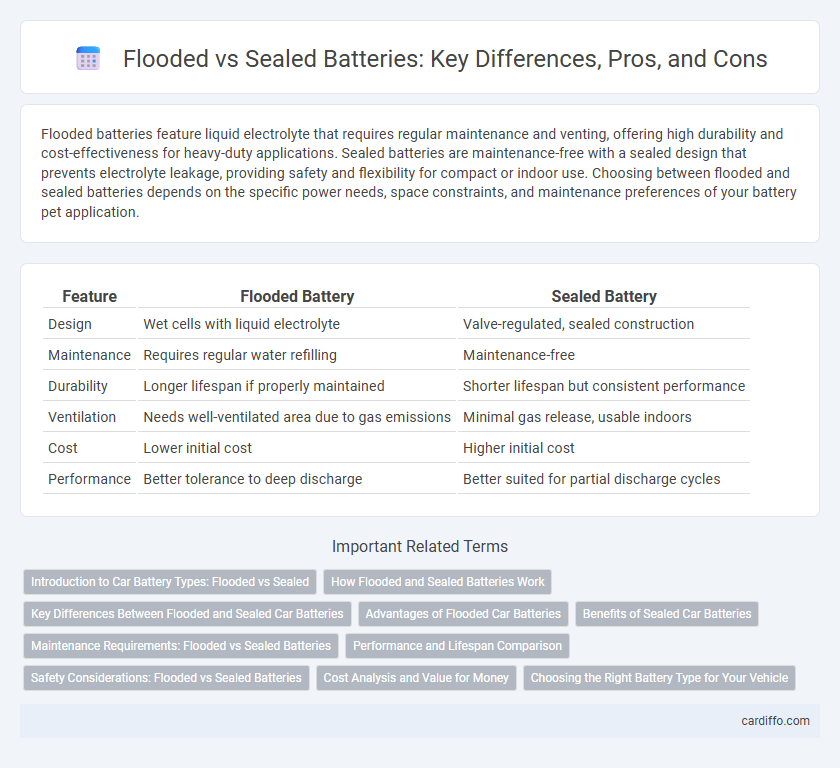Flooded batteries feature liquid electrolyte that requires regular maintenance and venting, offering high durability and cost-effectiveness for heavy-duty applications. Sealed batteries are maintenance-free with a sealed design that prevents electrolyte leakage, providing safety and flexibility for compact or indoor use. Choosing between flooded and sealed batteries depends on the specific power needs, space constraints, and maintenance preferences of your battery pet application.
Table of Comparison
| Feature | Flooded Battery | Sealed Battery |
|---|---|---|
| Design | Wet cells with liquid electrolyte | Valve-regulated, sealed construction |
| Maintenance | Requires regular water refilling | Maintenance-free |
| Durability | Longer lifespan if properly maintained | Shorter lifespan but consistent performance |
| Ventilation | Needs well-ventilated area due to gas emissions | Minimal gas release, usable indoors |
| Cost | Lower initial cost | Higher initial cost |
| Performance | Better tolerance to deep discharge | Better suited for partial discharge cycles |
Introduction to Car Battery Types: Flooded vs Sealed
Flooded car batteries contain liquid electrolyte that requires regular maintenance, such as topping up with distilled water, to ensure optimal performance. Sealed batteries, also known as maintenance-free or AGM (Absorbent Glass Mat) batteries, have a sealed design that prevents electrolyte leakage and reduces evaporation, offering enhanced durability and less frequent servicing. Choosing between flooded and sealed batteries depends on vehicle requirements, climate conditions, and maintenance preferences.
How Flooded and Sealed Batteries Work
Flooded batteries operate by submerging lead plates in a liquid electrolyte, allowing the electrolyte to flow freely and facilitate chemical reactions during charging and discharging. Sealed batteries, also known as valve-regulated lead-acid (VRLA) batteries, use a gel or absorbed glass mat (AGM) electrolyte that immobilizes the liquid, preventing spills and reducing maintenance. The sealed design relies on pressure relief valves to vent gases safely, maintaining a sealed environment and enhancing safety compared to flooded batteries.
Key Differences Between Flooded and Sealed Car Batteries
Flooded car batteries contain liquid electrolyte that requires regular maintenance such as topping off with distilled water, whereas sealed batteries use a gel or absorbed glass mat (AGM) design that is maintenance-free. Flooded batteries typically offer higher tolerance to overcharging and are more cost-effective, but sealed batteries provide better resistance to vibration and leakage with improved safety features. The choice between flooded and sealed batteries depends on factors like vehicle type, maintenance preferences, and environmental conditions.
Advantages of Flooded Car Batteries
Flooded car batteries offer superior cooling due to their liquid electrolyte, which enhances performance and extends battery lifespan in demanding conditions. They are generally more affordable and easier to maintain with the ability to check and refill electrolyte levels, ensuring consistent operation. These batteries also tolerate overcharging better than sealed ones, reducing the risk of damage in high-use or extreme temperature environments.
Benefits of Sealed Car Batteries
Sealed car batteries offer superior maintenance-free operation by preventing electrolyte spillage and minimizing water loss, making them ideal for modern vehicles. Their compact, leak-proof design enhances safety and reliability while providing consistent performance in extreme temperatures. Enhanced resistance to vibration and corrosion further extends the lifespan of sealed batteries compared to traditional flooded types.
Maintenance Requirements: Flooded vs Sealed Batteries
Flooded batteries require regular maintenance, including checking electrolyte levels and adding distilled water to prevent damage and ensure optimal performance. Sealed batteries, such as AGM or Gel types, are maintenance-free due to their sealed design, eliminating the need for water refilling or electrolyte monitoring. This difference significantly impacts the total cost of ownership and usability, especially in applications where low maintenance is crucial.
Performance and Lifespan Comparison
Flooded batteries offer superior performance in high-drain applications due to their efficient heat dissipation and ability to handle deep discharges, resulting in a lifespan of 3 to 5 years with proper maintenance. Sealed batteries, including AGM and gel types, provide lower maintenance and better resistance to vibration and leakage, generally lasting 4 to 7 years, but they may have reduced capacity under extreme temperatures. Performance trade-offs between flooded and sealed batteries depend on usage conditions, with flooded batteries favoring demanding environments and sealed batteries excelling in convenience and durability.
Safety Considerations: Flooded vs Sealed Batteries
Flooded batteries require regular maintenance to prevent acid spills and hydrogen gas buildup, posing safety risks without adequate ventilation. Sealed batteries, including AGM and gel types, offer enhanced safety by containing electrolyte and minimizing leakage or gas emissions, making them suitable for enclosed or poorly ventilated spaces. Proper handling and awareness of battery specifications are essential to mitigate hazards associated with both flooded and sealed battery technologies.
Cost Analysis and Value for Money
Flooded batteries generally offer lower upfront costs and easier maintenance, making them a cost-effective choice for users with regular access to upkeep. Sealed batteries, while more expensive initially, provide longer lifespan and reduced maintenance, delivering better value for money in applications where convenience and durability are prioritized. Evaluating total cost of ownership, including replacement frequency and service expenses, is crucial for determining optimal battery value.
Choosing the Right Battery Type for Your Vehicle
Flooded batteries offer easy maintenance and are cost-effective, making them suitable for vehicles with onboard battery management systems that can handle periodic water refills. Sealed batteries, such as Absorbed Glass Mat (AGM) and gel types, provide leak-proof design and better vibration resistance, ideal for vehicles with limited access to the battery or demanding performance needs. Selecting the right battery involves considering your vehicle's specific requirements, usage patterns, and environmental conditions to balance cost, maintenance, and reliability.
Flooded vs Sealed Infographic

 cardiffo.com
cardiffo.com